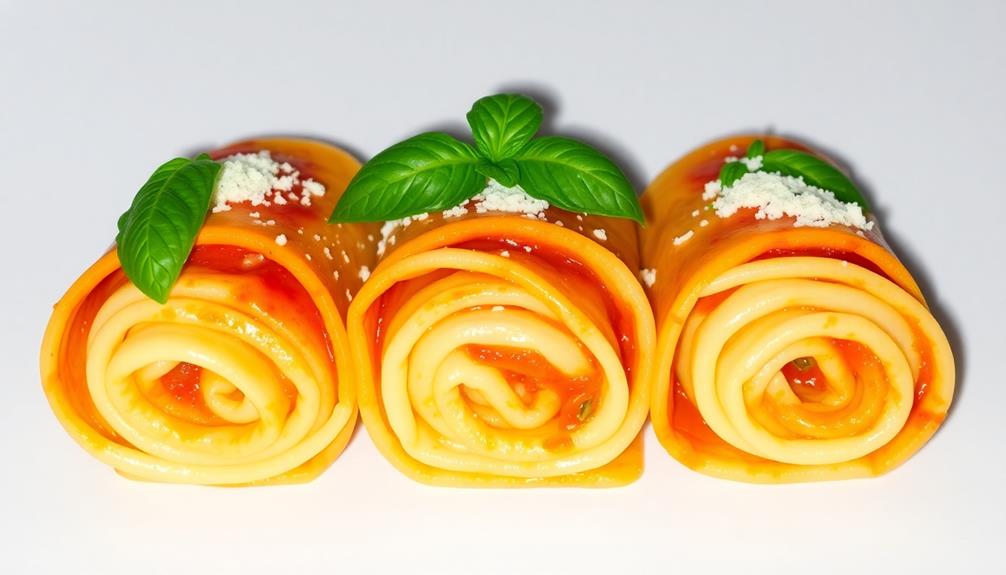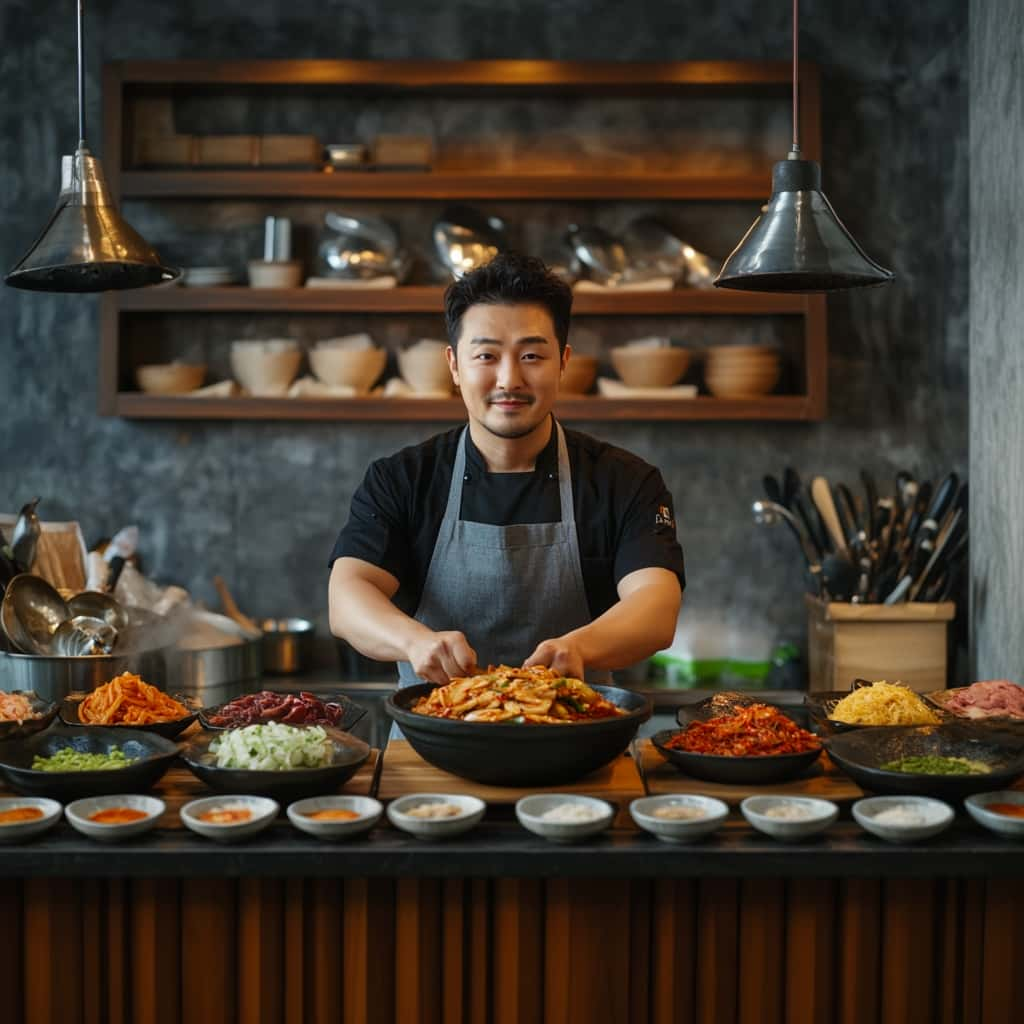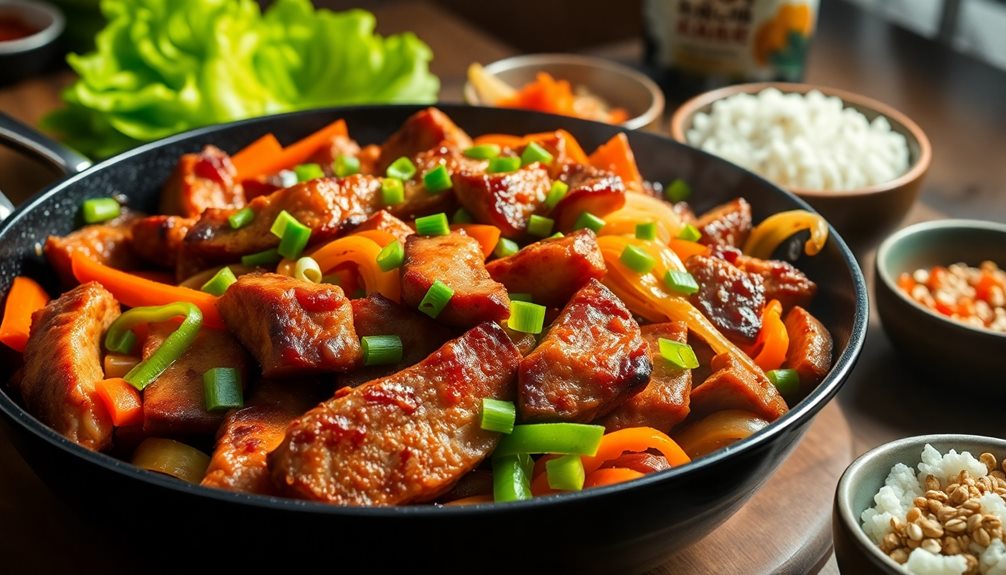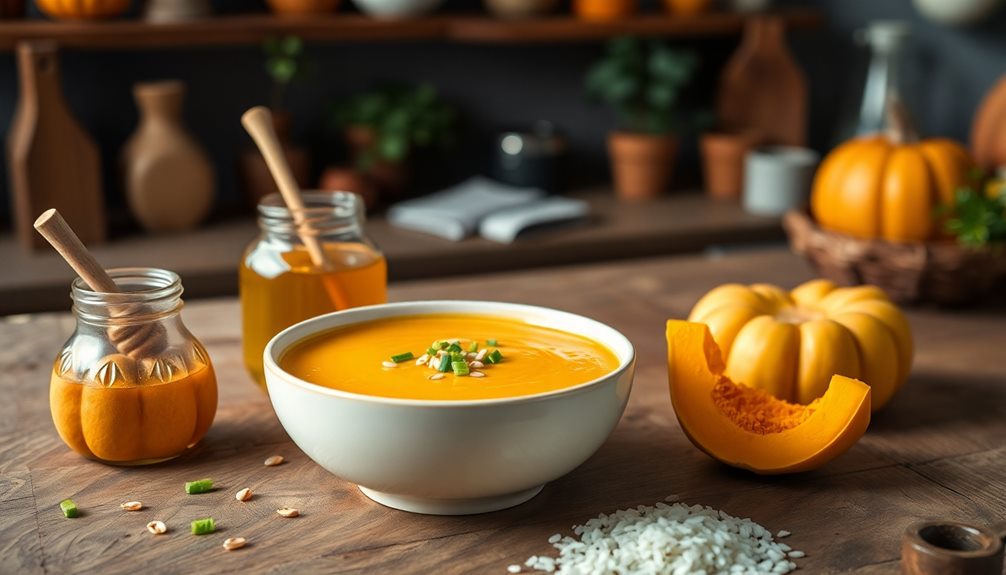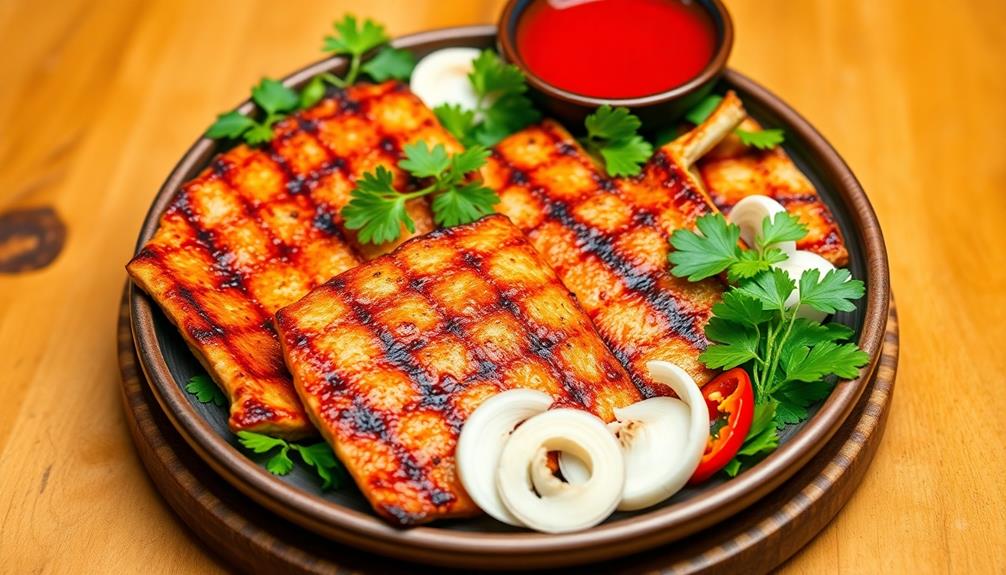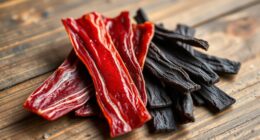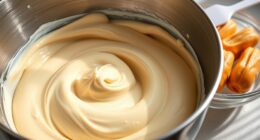Kongguksu is a yummy cold soybean noodle soup that's perfect for sunny days! Originating from Korea, this dish is made with chilled soy milk, making it creamy and nutritious. You'll soak soybeans, blend them, and strain the mixture to create a delicious broth. After chilling, cook your favorite thin noodles, rinse them, and then mix them with fresh veggies like cucumbers and tomatoes. Top it off with toasted sesame seeds for extra crunch! It's like a mini-vacation on a plate! If you stick around, you'll discover even more about how to make this refreshing treat.
Key Takeaways
- Kongguksu is a traditional Korean cold soybean noodle soup, popular for its refreshing qualities during hot summer days.
- The dish is made with chilled soy milk, noodles, and a variety of fresh vegetables and toppings.
- Nutritionally rich, Kongguksu offers a creamy texture and can be customized with ingredients like tofu or gochujang for added flavor.
- It is simple to prepare, requiring soaked soybeans blended with water, creating a nutritious broth that is served cold.
- Kongguksu represents a cherished aspect of Korean culture, evoking nostalgia and a sense of tradition in its preparation and enjoyment.
History
Kongguksu, a refreshing cold noodle dish, has roots that stretch back centuries in Korean cuisine. You might be surprised to learn that this delightful dish made with chilled soybean soup has been enjoyed since the Joseon Dynasty, which lasted from 1392 to 1897!
Back then, people loved cooling off with Kongguksu during hot summer days. Imagine sitting outside, enjoying a bowl of these slippery noodles, while the sun shines bright—sounds perfect, right?
Traditionally, Kongguksu was a staple for those who wanted a light meal, especially after long days in the fields. This tasty dish isn't only delicious but also healthy, thanks to the nutritious soybeans. When you dig into a bowl of Kongguksu, you're tasting a piece of history and culture that has been passed down through generations.
As time went on, this dish evolved, incorporating various toppings and flavors. Today, you can find it served in many Korean restaurants worldwide, allowing more people to experience its cool, creamy goodness.
Recipe
Kongguksu is a refreshing Korean cold noodle dish that's perfect for hot summer days. The main ingredient is chilled soy milk, which creates a creamy, nutty base for the noodles. Traditionally served with thinly sliced vegetables and a sprinkle of sesame seeds, this dish isn't only delicious but also nutritious. Its simplicity allows the natural flavors of the ingredients to shine through, making it a popular choice in Korean cuisine.
To prepare Kongguksu, you'll need to make a smooth and silky soy milk broth, which is the star of the dish. The soy milk can be store-bought or homemade, but using unsweetened soy milk is essential for an authentic taste. When combined with cold noodles, the dish offers a delightful contrast of textures and temperatures that will satisfy your palate. It's an excellent option for a light lunch or dinner, and it's also vegan-friendly!
Ingredients:
- 1 cup dried soybeans
- 4 cups water (for soaking)
- 4 cups water (for blending)
- 2 servings of thin wheat noodles (or any preferred noodles)
- Salt to taste
- 1 cucumber, thinly sliced
- 1 small zucchini, thinly sliced
- 2 green onions, chopped
- Sesame seeds for garnish
- Ice cubes (optional)
Cooking Instructions:
First, soak the dried soybeans in 4 cups of water for at least 8 hours or overnight. Drain and rinse the soybeans, then blend them with 4 cups of fresh water until smooth. Strain the mixture through a fine sieve or cheesecloth to extract the soy milk, discarding the pulp.
In a pot, bring water to a boil and cook the noodles according to package instructions. Once cooked, drain and rinse the noodles under cold water to cool them down. To serve, place a portion of noodles in a bowl, pour the chilled soy milk over them, and garnish with sliced cucumber, zucchini, green onions, sesame seeds, and a pinch of salt. Add ice cubes if you prefer it extra cold.
Extra Tips:
For an added depth of flavor, consider toasting the sesame seeds before sprinkling them on top of your Kongguksu. You can also customize your toppings by adding other vegetables such as radishes or carrots, or by incorporating tofu for extra protein.
If you like a spicy kick, a drizzle of gochujang (Korean chili paste) can elevate the dish even more. Be sure to serve it immediately after assembling to enjoy the perfect combination of cold noodles and creamy soy milk.
Cooking Steps
Get ready to make some delicious kongguksu!
First, you'll soak the soybeans overnight, which helps them become soft and creamy.
Once they're ready, blending and straining the mixture will create a smooth broth that's perfect for chilling and adding your favorite noodles and toppings!
Step 1. Soak Soybeans Overnight

Soaking soybeans overnight is a crucial step that enhances their texture and flavor for your Kongguksu. It's super easy, and you'll be amazed at the difference it makes!
To start, grab a cup of dried soybeans—make sure they're clean and free from any tiny pebbles. Next, place them in a large bowl and cover them with plenty of water. It's important to use enough water because the soybeans will soak it up like little sponges!
After you've added the water, let the soybeans sit at room temperature overnight. While they soak, they'll expand and soften, becoming plump and creamy—just what you want for that delicious noodle soup!
You might even want to imagine them getting ready for a big party, because that's how exciting this step is!
In the morning, you'll find your soybeans ready for action. Don't forget to drain them before moving on to the next step, which will involve blending them into a smooth, silky mixture.
Step 2. Blend Soaked Soybeans Thoroughly
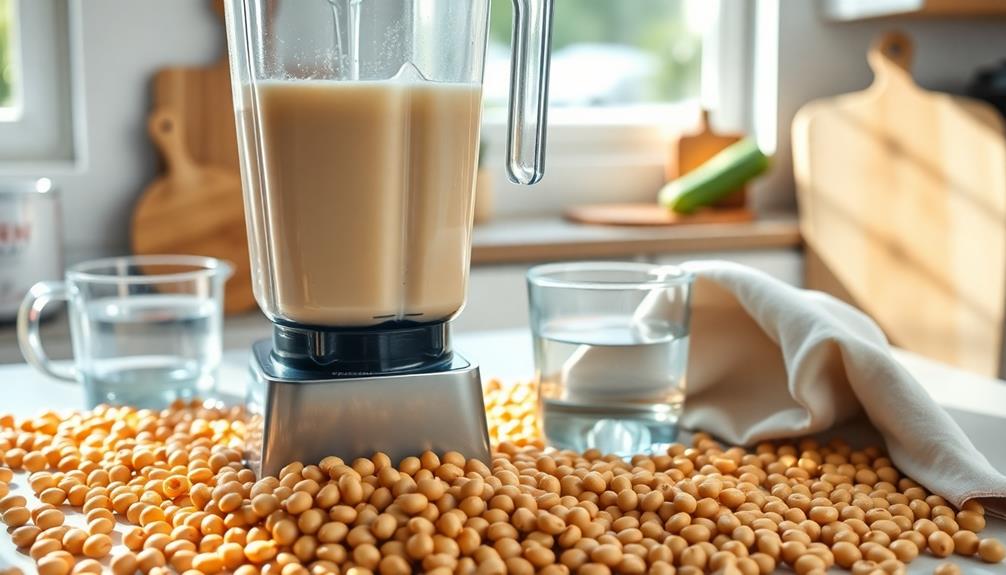
After draining the soaked soybeans, it's time to turn them into a smooth, creamy base for your Kongguksu. First, grab your blender. It's like a magic potion maker! Toss in the soaked soybeans along with about three cups of cold water. You want to give those beans a good whirl, so make sure the lid's on tight—no one wants a splash zone in the kitchen!
As you blend, consider adding a splash of herbal tea for relaxation to enhance your overall comfort while cooking.
Blend the mixture on high speed until it's completely smooth. This could take about a minute, and you might need to stop and scrape down the sides of the blender to get everything mixed well. If the mixture's a bit too thick, add a little more cold water to help it along. Remember, you want a creamy texture, not a chunky one!
As you watch the soybeans transform, imagine how delicious your noodle soup will be. You're doing great!
Once it's all blended smoothly, you'll be ready for the next step. Just think of this as the foundation of your tasty Kongguksu. Keep up the good work, and let's get ready to strain that creamy mixture next!
Step 3. Strain Soybean Mixture Carefully

Straining the soybean mixture is a crucial step in achieving that silky smooth texture for your Kongguksu. After you've blended those soaked soybeans really well, it's time to put your mixture through a fine mesh strainer or cheesecloth.
Place your strainer over a large bowl, and pour the blended mixture in. Don't rush it! Let it sit for a minute or two, so the liquid can drip down. You want to catch every last drop of that yummy soybean liquid, so gently press the mixture with a spatula or the back of a spoon. This helps squeeze out all the goodness.
As you do this, you might notice some leftover bits of soybean pulp. Don't worry, that's totally normal! You can set that aside; it's great for adding to smoothies or even using in baking.
Once you've strained everything, give the liquid a taste. It should be creamy and flavorful, ready to be the star of your soup! Remember, patience is key here—rushing can lead to a chunky soup, and nobody wants that!
Step 4. Chill the Soybean Broth

Now that you've got your silky soybean liquid, it's time to chill the broth for that refreshing Kongguksu experience. Once the broth is chilled, it’s time to prepare the seasoned soybean sprouts recipe that will accompany the Kongguksu. Boil a pot of water and blanch the soybean sprouts for a few minutes until they are tender-crisp. Then, toss them in a mixture of soy sauce, sesame oil, sugar, and chopped green onions for a delicious and flavorful side dish.
First, pour your strained soybean broth into a large bowl or container. The wider the surface area, the faster it'll cool down. You can pop it in the fridge, but if you want to speed things up, consider using an ice bath. Just fill a bigger bowl with ice and water, then place your container inside. Voilà! Instant chill!
While it cools, keep an eye on it. You want it to be nice and cold but not frozen solid. This usually takes about 30 to 60 minutes. If you're feeling a little impatient, you can stir it occasionally to help the cooling process along. Just think of it as giving your broth a little spa treatment!
Once it's perfectly chilled, taste it! If it needs a little extra flavor, feel free to add a pinch of salt or even a splash of soy sauce.
Now, you're one step closer to enjoying your delicious Kongguksu. Can you almost taste that creamy, cold goodness? Keep going; you're doing great!
Step 5. Add Noodles and Toppings
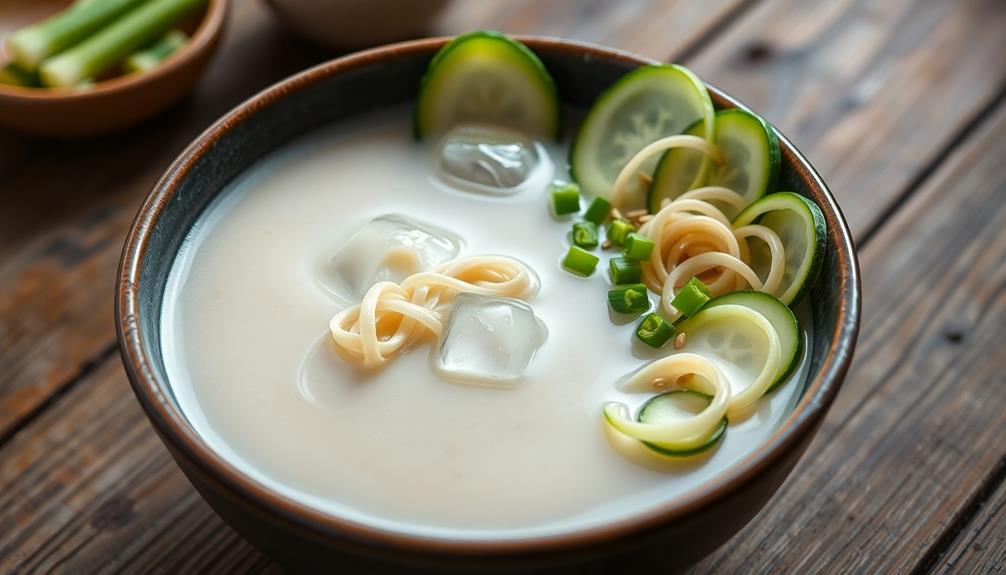
With your chilled soybean broth ready, it's time to bring your Kongguksu to life by adding the noodles and toppings. First, cook your noodles according to the package instructions, usually just a few minutes. Once they're done, drain them and rinse under cold water to keep them cool.
Now, gently place the noodles into your chilled broth, making sure they're evenly spread out.
Next, it's time for the fun part—adding toppings! You can use sliced cucumbers, which add a nice crunch, or maybe some cherry tomatoes for a pop of color. Don't forget the toasted sesame seeds! They add a nutty flavor that makes everything even better.
If you want to get fancy, you can add a sprinkle of seaweed strips or even some boiled egg slices.
Once you've arranged your toppings just the way you like, grab a pair of chopsticks or a fork, and get ready to dig in! Your Kongguksu isn't only delicious, but it's also super refreshing on a hot day.
Enjoy your tasty creation, and don't be surprised if you want to make it again tomorrow!
Final Thoughts
Kongguksu is more than just a dish; it's a refreshing experience that captures the essence of summer in South Korea.
When you take that first slurp of cold soybean noodle soup, you're not just tasting something delicious; you're enjoying a tradition that's been loved for generations. The smooth, creamy broth cools you down, making it perfect for hot days when you need a pick-me-up.
Imagine sitting outside, feeling the warm breeze, and savoring each bite of your kongguksu.
It's like a mini-vacation on your plate! You can even customize it with your favorite toppings, like crunchy cucumbers or roasted sesame seeds, to make it your own.
Frequently Asked Questions
What Are the Health Benefits of Eating Kongguksu?
Eating a variety of foods offers numerous health benefits. You get essential nutrients, improve digestion, and boost your energy levels. Incorporating diverse dishes can enhance your overall well-being and keep meals exciting and enjoyable.
Can I Substitute Ingredients for a Vegan Version?
Absolutely, you can substitute ingredients for a vegan version. Use plant-based proteins, like tofu or tempeh, and replace dairy with nut milk or coconut cream. Experiment with fresh veggies to enhance flavor and nutrition!
Where Can I Find the Best Kongguksu in Korea?
You'll find the best options at local markets and popular eateries, where chefs specialize in traditional dishes. Don't hesitate to ask locals for recommendations—they'll point you to hidden gems you won't want to miss!
How Should I Store Leftover Kongguksu?
To store leftovers, pour them into an airtight container and refrigerate. It'll keep fresh for about three days. When you're ready to eat, just reheat gently and enjoy your meal again!
Is Kongguksu Gluten-Free?
Yes, Kongguksu is gluten-free since it primarily consists of soybeans and noodles made from gluten-free ingredients. Just make sure to check the noodle packaging to confirm they don't contain any gluten or wheat products.

